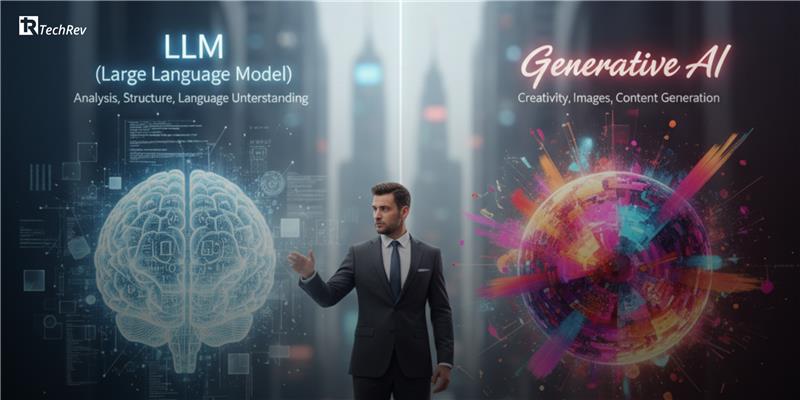
What’s the real difference between a Large Language Model (LLM) and Generative AI? Basically, LLM vs Generative AI!
If you’ve been following the rapid evolution of Artificial Intelligence, you’ve likely seen both terms used interchangeably. But here’s the truth: while every LLM is a type of Generative AI, not every Generative AI is an LLM. Confusing? Don’t worry, we’ll break it down in this blog.
By the end, you’ll know:
- What an LLM really is.
- How Generative AI goes beyond just text.
- Which AI-powered solutions are best for your business in 2025?
What is a Large Language Model (LLM)?
An LLM (Large Language Model) is an AI model trained on massive datasets of text. Think of it as a powerful prediction engine; it analyzes words and generates the next most likely word in a sequence.
Examples of LLMs include OpenAI’s GPT models, Google’s Gemini, and Meta’s LLaMA (an open-source LLM).
Key Features of LLMs
- Specializes in text generation, summarization, and Q&A.
- Great for chatbots, virtual assistants, and content creation.
- It can be fine-tuned for specific industries like finance, healthcare, or legal services.
Top Large Language Model Use Cases
- Chatbots and virtual assistants
- Customer support automation
- Legal or financial document drafting
- Knowledge retrieval and research summaries
- Code generation (fine-tuned LLMs for developers)
What Is Generative AI?
Generative AI (GenAI) is a broader category. It includes LLMs but also extends to image, video, audio, and code generation.
In short: LLM = Text-only while Generative AI = Multi-modal (text, image, video, audio).
Top Examples of Generative AI
- Text – ChatGPT, Anthropic’s Claude
- Images – MidJourney, Stable Diffusion, DALL·E
- Video – Runway Gen-2, Synthesia
- Code – GitHub Copilot
- Audio/Voice – ElevenLabs, AIVA
Popular Use Cases of Generative AI
- Marketing creatives (ads, product visuals, taglines)
- Cybersecurity (synthetic data for attack simulations)
- Customer service (AI-powered chat + voice agents)
- Education (personalized learning materials)
- Healthcare (AI imaging, drug discovery simulations)
Also Read – AI in Drug Discovery: A Game Changer for Custom Healthcare App Development!
LLM vs Generative AI: Quick Comparison!
| Features | LLM | Generative AI |
| Defination | A type of artificial intelligence model trained on text data. | A broad category that includes text, image, audio, and video models. |
| Capabilities | Text generation, summarization, Q&A, translation. | Multi-modal creation: text, images, audio, video, code. |
| Examples | GPT-4, LLaMA (open source LLMs) | ChatGPT, MidJourney, Runway, DALL·E |
| Use Cases | Chatbots, knowledge assistants, customer support. | Marketing creatives, product design, cybersecurity detection, and healthcare imaging. |
| Impact of AI Development Services | Best for building industry-specific chatbots or documentation assistants. | Best for multi-media apps, design tools, and cross-industry AI-powered solutions. |
Why This Matters in 2025?
Businesses investing in AI are asking: Should we rely on LLMs or build broader Generative AI systems?
- LLMs are cost-effective and great for focused text tasks.
- Generative AI offers creativity, flexibility, and scalability for multiple domains.
If you’re exploring AI app development services, your choice will depend on whether you need simple text automation or multi-modal intelligence.
Large Language Models vs Generative AI: When To Choose What?
Choose LLMs When:
- You need text-heavy automation (chatbots, Q&A systems).
- Your focus is on knowledge-based apps (legal, finance, healthcare documents).
- You want a lower AI software price compared to multi-modal systems.
Choose Generative AI If:
- Your business requires multi-modal output (text + visuals + audio).
- You’re looking for creative automation in marketing, product design, or education.
- You need AI-powered solutions for industries like cybersecurity or healthcare imaging.
Also Read – How AI Development Services Can Boost Your Business in 2025?
The Role of Open Source LLMs in 2025
Businesses are increasingly adopting open-source Large Language Models like LLaMA, Falcon, and Mistral. Why? Lower AI software price, transparency, and flexibility in customization.
However, open source models also present challenges such as data privacy, AI app deployment costs, and scaling issues. That’s where expert AI app development services make a difference.
How TechRev Helps Businesses Leverage AI in 2025?
At TechRev, we don’t just talk about AI, we build it into real, revenue-driving products.
Our expertise includes:
- AI app development services tailored to enterprise needs.
- Building custom artificial intelligence models (LLMs + Generative AI).
- Offering end-to-end AI-powered solutions for healthcare, fintech, and retail.
- Helping businesses navigate AI software pricing with scalable, cost-effective strategies.
Whether you want to deploy an open source LLM, design a Generative AI platform, or create a niche AI automation app, TechRev can help.
Conclusion
In the LLM vs Generative AI debate, the right choice isn’t about picking one over the other; it’s about knowing when to use which.
- Choose LLMs when your focus is on text automation, chatbots, or knowledge management.
- Choose Generative AI when you need multi-modal creativity and broader automation.
And if you’re unsure, partnering with a trusted AI app development company like TechRev ensures your business leverages the best AI-powered solutions in 2025.
Also Read – Building Custom AI Chatbot for Healthcare, Finance, and Legal!
FAQs
Ans. An LLM is an artificial intelligence model designed to understand and generate human-like text.
Ans. Generative AI (GenAI) refers to AI systems that can create new data (text, images, video, or audio) rather than just analyze existing data.
Ans. LLMs are limited to text. They can’t generate images, videos, or audio, while Generative AI covers all these domains.
Ans. LLMs – Legal tech, education, customer service.
Generative AI – Healthcare, marketing, cybersecurity, product design.
Ans. LLMs – Fine-tuned with domain-specific text datasets.
GenAI models are fine-tuned with images, videos, or multi-modal datasets, depending on the use case.
Ans. Generative AI can simulate cyberattacks, detect vulnerabilities, and train defense systems using synthetic data, something LLMs alone cannot do.
Ans. It can simulate cyberattacks, generate synthetic data, and improve defense training.
